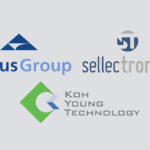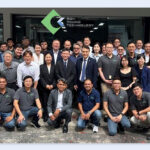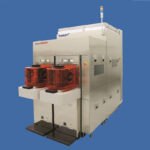ASIA ELECTRONICS INDUSTRYYOUR WINDOW TO SMART MANUFACTURING
Koh Young’s Novel Tech Soars Inspection to New Heights
The advent of sophisticated manufacturing technologies have brought advancements in electronics manufacturing. For cutting-edge inspection solutions provider Koh Young Technology, Inc., automation in electronics manufacturing have been driven by the increasing need for efficiency, precision, and adaptability.
Recently, the power of artificial intelligence and machine learning have brought traditional production lines into a more intelligent and interconnected smart factories. In an interview with AEI, Brent Fischthal, Head of Global Marketing Communications at Koh Young, said for manufacturers, these advancements would mean higher throughput and consistency while for end products, it will ensure better reliability and performance.

“These advancements enable real-time data analysis, predictive maintenance, and adaptive process controls—leading to improved product quality, reduced operational costs, and enhanced production flexibility,” said Fischthal.
Koh Young has been providing smart factory solutions that demonstrate the real-world value of automation. The company has KSMART platform leverages AI to enable closed-loop process optimization, helping customers make real-time adjustments that improve yield and reduce defects. Specifically, Koh Young has a rich lineup of inspection systems that help manufacturers minimize human error in production. Thus, elevating production outcomes and operational efficiency.
Inspection systems such as automated optical inspection (AOI) play critical role in electronics manufacturing, ensuring printed circuit boards and assemblies meet strict quality standards. As it uses advanced imaging and machine learning algorithms, AOI systems detect defects, misalignments, and soldering issues before they lead to failures in the final product. Its more modern 3D AOI technology variation enhances the traditional AOI processes, providing a more depth information and reducing false positives, thus ensuring a more accurate inspection.
In this interview with AEI, Fischthal outlines the trends in PCB assemblies and how sophisticated technologies such as AI shape the landscape of PCB assembly inspection.
AEI: What are some trends related to components and PCBs and how do these make it more challenging to manufacturers?
Fischthal: Today’s electronics demand smaller, faster, and more multifunctional designs, which has led to major shifts in component and PCB complexity. Trends such as miniaturization, increased component density, heterogeneous integration, and the use of advanced board materials are pushing the limits of traditional inspection and assembly capabilities. Ultra-fine pitches, micro-BGAs, and 0201M components leave no room for error. At the same time, mixed technology assemblies and double-sided PCBs requires flexible, highly accurate process control and traceability.

AEI: Can you explain the importance and synergies of AOI and SPI systems in PCB assembly and how these inspections have become crucial?
Fischthal: Inspection is no longer just a quality checkpoint—it is now a vital process control mechanism in PCB assembly. SPI and AOI systems each provide feedback at key stages of the surface mount line: SPI evaluates paste application post-printing, while AOI identifies placements after component mounting and soldering defects after reflow. Together, they form a powerful closed-loop feedback system that helps identify root causes and correct process drift early to significantly improve yield and stability.
At Koh Young, our SPI and AOI systems share a unified True 3D measurement foundation, delivering consistent, reliable data that enhances defect detection and process insight. The KY8030 SPI system monitors critical solder volume and alignment metrics, while our Zenith AOI system verifies component presence, polarity, coplanarity, and solder joint quality with accuracy. These systems integrate seamlessly with our KSMART software and KPO to adjust upstream equipment settings in real time. Rather than waiting to catch defects after the fact, manufacturers can now prevent them and support a more reliable, cost-effective, and yield-optimized production flow.
AEI: How have AOI systems evolved over the years, and what are the prevailing trends in inspection that enhance PCB assembly?
Fischthal: AOI has transformed from basic 2D visual inspection into an intelligent 3D metrology platform that supports precision manufacturing. Early systems primarily relied on contrast-based imaging and were limited in their ability to quantify defects—especially as boards became more complex. With the increasing demand for accuracy, traceability, and automated analysis, the industry transitioned to True 3D inspection systems capable of measuring height, volume, and shape with high resolution and consistency.
AEI: How did Koh Young adopted to these trends?
Fischthal: Koh Young led this shift by introducing the first True 3D AOI system, and we continue to set the standard for advanced inspection. Our Zenith series uses patented multi-projection Moiré technology to eliminate shadowing and reflection issues, capturing detailed, quantitative data on every solder joint and component.
Current trends also highlight the integration of AI for smarter defect recognition, adaptive thresholding, and more consistent classification, all capabilities we have embedded into Smart Review. Combined with connectivity through KSMART and process optimization via KPO, Koh Young AOI systems do more than inspect; they guide continuous process improvement, drive yield enhancements, and support greater automation throughout PCB assembly.

AEI: Which application industries are advanced AOIs highly suitable for?
Fischthal: Advanced inspection systems are critical across nearly every electronics manufacturing sector. Whether driven by safety, performance, compliance, or cost, all industries require reliable, consistent inspection to meet their production and quality goals. Automotive, aerospace, medical, industrial, telecommunications, and consumer electronics all rely on advanced inspection to verify complex assemblies, ensure compliance with stringent standards, and reduce the risk of product failure in the field.
Koh Young’s True 3D inspection systems deliver the flexibility and precision needed to meet these diverse industry demands. In automotive, our systems help meet functional safety requirements like ISO 26262 by verifying solder joint integrity and ensuring traceability. In medical electronics, where zero tolerance for defects is critical, our metrology-based approach supports compliance with regulatory standards. Aerospace and defense manufacturers rely on Koh Young for high-accuracy inspection and detailed reporting, while high-volume consumer electronics producers benefit from our ability to reduce false calls and maximize throughput. Across all sectors, our solutions provide the trustworthy data needed to raise quality, reduce rework, and strengthen customer confidence.
AEI: Which technologies play a crucial role in further advancing electronics manufacturing into the Industry 4.0 era?
Fischthal: The Industry 4.0 era is defined by intelligent automation, data-driven decision-making, and seamless connectivity between systems. In electronics manufacturing, core technologies like the Industrial Internet of Things (IIoT), data analytics, AI, and machine learning enable a shift from static processes to dynamic, responsive operations. These tools facilitate communication between machines, empower predictive analysis, and support real-time decision-making, all of which contribute to greater efficiency, yield, and quality.
Koh Young integrates these technologies across our smart factory solutions to help manufacturers fully harness the benefits of Industry 4.0. Our KSMART platform aggregates inspection data from SPI and AOI systems to provide centralized, real-time process visibility. By leveraging the connectivity of our True 3D inspection platforms, we enable manufacturers to apply AI and data analytics in ways that make continuous improvement actionable. AI-driven solutions like KPO automatically refine process settings for printers and mounters, while tools such as Auto Programming streamline setup and Smart Review enhances defect classification with machine learning. These intelligent capabilities allow manufacturers to stay agile, reduce variation, and optimize operations.
AEI: With trends toward Industry 4.0 and AI, can you explain how Koh Young actually made use of these technologies in your inspection systems?
Fischthal: Koh Young has fully embraced Industry 4.0 and artificial intelligence as essential to advancing electronics manufacturing. Rather than limiting inspection to post-process checks, we have embedded intelligence into our systems to support real-time control, predictive analytics, and autonomous optimization – key smart factory attributes.
At the core of our strategy is the KSMART platform, which connects SPI and AOI systems to collect and analyze production data in real time. This data-driven environment enables better decision-making, process transparency, and traceability. AI and machine learning enhance several core capabilities: Smart Review improves classification accuracy by learning from operator decisions; Auto Programming uses AI to accelerate setup; and KPO closes the loop by automatically adjusting printer and mounter parameters based on inspection feedback. Together, these capabilities reduce manual intervention, improve consistency, and streamline operations.
AEI: Because of AI and other emerging technologies, is the industry close to zero-defect PCB manufacturing?
Fischthal: The electronics industry is rapidly approaching the long-held goal of zero-defect manufacturing, thanks to advances in AI, machine learning, and intelligent process control. While it may not yet be feasible to eliminate all defects across all scenarios, manufacturers can now dramatically reduce variation and prevent most issues before they occur. By shifting quality control from reactive inspection to proactive process management, today’s technologies are enabling breakthrough improvements in consistency, efficiency, and reliability.
Koh Young is charging hard to make this vision a reality. Our True 3D inspection platforms generate accurate, high-resolution data that allows manufacturers to monitor and improve every stage of the SMT line. With AI-powered systems like KPO, we help customers tune upstream processes automatically based on inspection results—effectively preventing defects rather than simply detecting them. Intelligent tools like Smart Review and Auto Programming further reduce manual input and support faster, more accurate decisions.
We are dedicated to advancing smart inspection technologies that bring manufacturers closer than ever to a zero-defect future.
Koh Young stands at the forefront of the electronics manufacturing industry as a visionary leader committed to advancing smart factory transformation. By combining True 3D measurement-based inspection with powerful AI and machine learning technologies, we deliver solutions that move beyond traditional defect detection toward intelligent process optimization. Our integrated platforms – spanning SPI, AOI, and advanced process control – provide manufacturers with the real-time insights and automation they need to reduce costs, enhance product quality, and increase operational efficiency. Backed by a global network of dedicated AI development teams and a legacy of innovation, Koh Young continues to shape the future of manufacturing with intelligent, data-driven solutions that enable a more agile, connected, and productive factory environment.
17 May 2025




